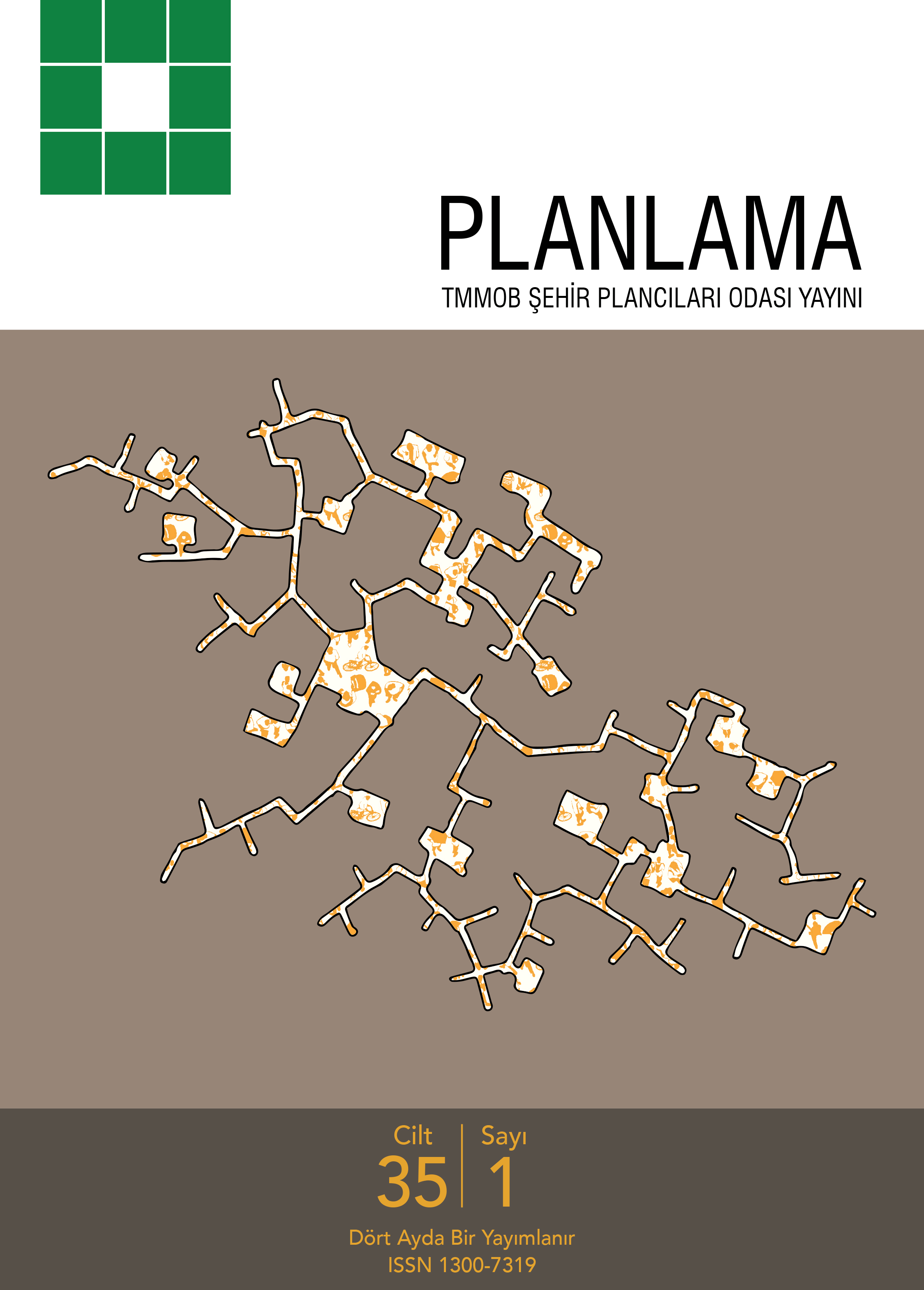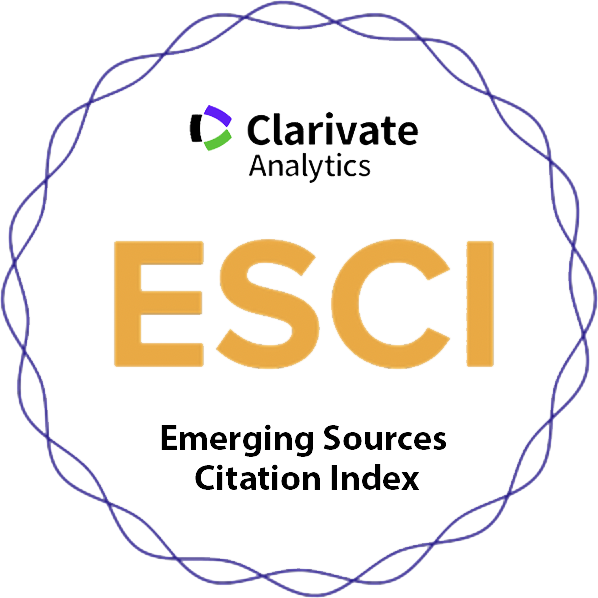Volume: 33 Issue: 1 - 2023
| OTHERS | |
| 1. | Frontmatters Pages I - V |
| EDITORIAL | |
| 2. | Editorial Page X |
| RESEARCH ARTICLE | |
| 3. | Ethnic Reflections of the Global Outbreak: A Multi-Dimensional Examination on Syrian Refugees and Settlements in the First Phase of the Coronavirus Outbreak Zerrin Ezgi Haliloğlu Kahraman doi: 10.14744/planlama.2022.38980 Pages 1 - 14 This study aims to examine the effects of the coronavirus pandemic on Syrian refugees at the neighbourhood level within the framework of perceptions, personal protection experiences, economic and social structure, and practices of neighbourhood usage. The major data source of this qualitative study included in-depth interviews with Syrian refugees living in Ulubey-Onder Neighbourhoods (Ankara). The findings displayed the effects of the pandemic on Syrians and their settlements, and a comparison before and after the outbreak. The study demonstrated that the effective information sources of Syrians are composed of social and communicational networks, and social media platforms. Their religious beliefs and social and economic needs both shape their perception on not being contaminated, and explain their reaction towards and resistance to respect the measures of the outbreak. Their lack of knowledge on available health services, attitudes of ignoring the use of face masks and social distancing rules, family structures, and living and working conditions increase the risk of the spread of the virus. Although the crowded streets proved that human movement and commercial vitality in Syrian settlements continue as it was before the pandemic, the family incomes and standards of living diminished due to laid offs and limited access to donations of NGOs. This led to empowerment of solidarity networks and social relations in the area. Additionally, this study found out both gender differences in socialization opportunities, and negative effects of curfews and suspension of congregational praying activities on social life during pandemic times. |
| 4. | Criteria for Location-Planning-Design of Bazaar Places and a Preliminary Assessment for the Post-COVID-19 Period Burcu Ceylan, Aygün Erdoğan doi: 10.14744/planlama.2022.98216 Pages 15 - 39 With the advent of agricultural revolution, sedentary lifestyle called for people to exchange their surplus goods in return for the others they need. In settlements, emerged by this tradition, bazaars became the first commercial places where the sellers and buyers meet. Being one of the most important public places in the culture and daily-life of a particular locality from past to present, it is essential for bazaars to be located, planned, and designed in line with the requirements of the time so that they sustain their existence properly. COVID-19, initial cases of whichironicallywere seen among the staff of a live-animal and seafood wholesale wet market in Wuhan, China in December 2019, shortly transformed into a global pandemic, changed our daily routines by directly affecting the use of especially open public spaces and commercial places. Thus, these spaces and land-uses need to be reconsidered in terms of the new normals and physical distance rules during and after the coronavirus pandemic. This study, which also includes evaluations for the post-COVID-19 period, aimed at a set of holistic criteria for the location-planning-design of bazaar places that are important for social life in Türkiye regarding their public-commercial use. Accordingly, after examining the before and ongoing COVID-19 literature, world bazaars, and legislation; locational, planning, and design scale properties of bazaars that would effectively serve a local population are put forward by introducing the Bazaar Places Planning Table (BPPT). Subsequently, a simple version of BPPT is tested for bazaar places of a medium-scale city. |
| 5. | Conceptual Framework for Cultural Heritage Management Planning and the Analysis of Related Graduate Thesis Studies Evrim Ulusan doi: 10.14744/planlama.2022.93276 Pages 40 - 57 The concept of management planning started to develop as a strategic spatial planning approach applied in cultural heritage places in the 1980s as a result of the paradigm shifts in the axis of neoliberalism, environmentalism and postmodernism. It was legalized in the international protection legislation in the early 2000s, and accordingly in Türkiye in 2004, upon the amendment made in the Law on the Protection of Cultural and Natural Assets No 2863. Practical experience and related academic research have improved since then, yet a detailed analysis of this academic research that would help building a link between heritage management theory and practice is absent. This article aims firstly to present socio-political strands that led to the emergence of this multifaceted concept, and then to analyze the academic interest in heritage management planning in cultural sites through post-graduate thesis studies in order to initiate a discussion on the relationship of management planning theory and practice within the Turkish context. The research outputs include a summary of dimensions analyzed and methodologies applied in the research conducted to date as well as considerations of dimensions that require further interest. |
| 6. | Examination of the Traces of İstanbul Golden Horn Walls Between Ayvansaray and Cibali Districts within the Context of Urban Dynamics and Conservation Approach Funda Server Kerestecioğlu, Melis Bilgiç doi: 10.14744/planlama.2022.69335 Pages 58 - 85 The Golden Horn Sea Walls that were built simultaneously with the development of the city, as one of the defence buildings are a significant component of the historical stratification and cultural accumulation of Istanbuls Historical Peninsula. Although it has been severely destroyed by urban transformations during the historical process, the part of it between the districts of Ayvansaray and Cibali has remained as ruins with various building groups or urban areas. But it is quite detached from and unnoticeable in its historical context. It is considered that the high level of invisibility of the Sea Walls, awareness of the preservation of it has not been quite developed. In this study, losses of the original integrity and the existing traces of the Sea Walls are detected and urban preservation problems of the remaining walls between Ayvansaray and Cibali are determined. The first phase of the study includes determination of the turning points in the light of urban dynamics in the chronological development of Istanbul with the developments of the conservation knowledge and the transformation of other city walls in the World. In the second phase, the current situation is determined through spatial analysis method and scaled photographs of the remainings of the Sea Walls between Ayvansaray and Cibali districts. Preservation problems within the context of urban dynamics have presented such as public works and zoning activities, unproper transportation decisions, unplanned new buildings, lack of functional, spatial and social continuity and absence of the integrated "management plan" that includes different interest groups. |
| 7. | Using Personal Rapid Transit as an Effective Transport Solution in Historical Downtown Areas: A Case from Historic Kemeraltı, İzmir Yavuz Duvarcı, Figen Akpınar doi: 10.14744/planlama.2022.69926 Pages 86 - 104 Many issues related to the conservation of urban heritage are closely related to the transit system and the use of private transportation. Regeneration, revitalization, and/or heritage conservation are not properly managed due to problems arising directly from inconvenient transport solutions that cannot provide or resolve the accessibility and mobility needs of vulnerable groups together with inappropriate space management while indirectly causing economic shrinkage and loss of vitality. Furthermore, even if modern modes of transportation are used, they will cause significant environmental and societal difficulties, making them unsuitable for such sensitive places. This article, using a micro-simulation approach, investigates whether a Personal Rapid Transit system is physically applicable, and whether it can meet existing travel requirements to prove that it is sufficient for the needs of local level mobility, and finally whether other environmental/social impacts such that land use, air pollution, safety, sustainability are positive or negative. As a method, these outputs of the system application are presented as validations of the usefulness of the PRT. Finally, it was found that there is a gain in productivity in terms of mobility as well as other socio-economic benefits besides the physical applicability of the method. The study's goal is to get the information out about how PRT technology may help produce more ecologically friendly and sustainable solutions while also conserving historical assets. |
| 8. | Development of A Neighborhood Sustainability Assessment System for Turkey: SEEB-TR Neighbourhood Sema Ergönül, İnci Olgun, Çiğdem Tekin, Nazire Papatya Seçkin, Mustafa Özgünler, Cem Baççıoğlu, Esra Turgut, Özge Boso Hanyalı doi: 10.14744/planlama.2022.35683 Pages 105 - 122 It is extremely important to improve energy efficiency in all sectors and to spread the use of renewable energy resources to protect natural resources, especially to prevent environmental pollution with renewable products, buildings, processes, technologies, and services. Indicators of the transformation of knowledge and technology into economic value in the building development process are that the operating costs will decrease since environmentally friendly buildings are energy efficient throughout their life cycle and spatial quality is audited by certification systems. In this context, directives and directions foresee a holistic approach in the fields of energy, planning, and housing at an upper scale. The establishment of transportation, energy, and technology infrastructures is the issues that need to be emphasized especially in the city, building, and product scale. The evaluation of techno-logical solutions together with communityoriented solutions may help to improve the built environment. In this sense, sustainability assessment systems at urban scale provide solutions to some transformation matters and also set ground to obtain a shared vision by bringing together many actors. This kind of system, which is the reflection of planning policies in developed countries, is not yet available in Turkey. This paper introduces SEEB-TR Neighborhood assessment system which is developed specifically for Turkey as a new measurement and monitoring tool. It is considered that the developed system will be a quality assessment criterion for urban space in the construction sector. |
| 9. | Controlling Accessibility for an Inclusive Public Life in a Neighbourhood İlkay Dinç Uyaroğlu doi: 10.14744/planlama.2022.15045 Pages 123 - 142 Spatial accessibility is one of the prerequisites for creating an inclusive public life in cities. Its success depends on intellectual, architectural, legal, and organisational aspects. Although legal rules about accessibility included in laws, regulations, and technical design standards mandate necessary architectural criteria for an inclusive public life, individuals might still be excluded from urban spaces and therefore deprived of their fundamental rights and freedoms in public life. This study focuses on why inclusive urban streets and public spaces have not been created yet in Turkey, although legal documents clearly dictate requirements for providing accessible environments for all. In this context, it is aimed to evaluate the intellectual, architectural, legal, and organizational infrastructure of accessibility practices at the neighbourhood scale. The concept of 'control' in the design and implementation of inclusive public spaces is discussed with the parameters of 'access' and 'control' defined by Kevin Lynch (1981) in his theory of 'Good City Form' based on efficient and fair city life. Çiğdem Neighbourhood, where local management is tried to be carried out with a participatory approach, was chosen as the sample area in this study. In Çiğdem District, which is managed in a collective structure, in-depth interviews are held with relevant stakeholders, and how accessibility management is experienced, the existence and weaknesses of a working and communication environment together are discussed. In the light of the theoretical approach of the study and the information obtained from the field study, the result of the study includes evaluations and suggestions on the accessibility monitoring and controlling process and organizational communication environment at the neighbourhood scale. |
| 10. | Local Capacity in Urban Conservation, Case Studies; Gaziantep and Şanlıurfa Burak Belge doi: 10.14744/planlama.2022.59489 Pages 143 - 166 When we evaluate urban conservation inteventions and their adoption by the local people, it is seen that the studies carried out in some cities are more successful than in similar ones. International documents define urban conservation as a joint responsibility of different actors rather than the task of a specific institution. The responsibility requires consciousness and awareness at every level of society. The roles of local actors and institutions in conservation activities are essential because of their direct relationship within the historical environment. In this context, the article describes the term of local conservation capacity that will be defined as a factor in the success and effective results of urban conservation process. Local conservation capacity is defined as the whole of the interrelationship network between local authorities and the local community, together with their competence, experience, know-how, and dedication to urban conservation. Gaziantep and Şanlıurfa were selected as case study areas in order to elaborate local conservation capacity. In both cities, some sort of urban conservation works had been completed since 2004, so a comparative evaluation is probable to be made for a period of approximately 20 years. In this context, first of all, based on the results of the research completed in 2011 it is emphasized that the local conservation capacity in Gaziantep is higher than in Şanlıurfa, especially in terms of ability to working together. Afterward, an evaluation is made based on differences in local conservation capacity, changes in the region and cities in the last 10 years. |
| 11. | What is the Contribution of a Riverside Design Project to the Establishment of Social Justice in the City? Fatih Eren, Kübra Ayşe Yıldız Keçer doi: 10.14744/planlama.2022.54227 Pages 167 - 183 One of the prominent aims of spatial planning is to establish social justice. However, the establishment of social justice in cities does not happen all at once. Every urban project result in a redistribution of benefits and costs in society. In this way, urban projects make a positive or negative contribution to the formation of social justice. This study aims to determine the economic benefits and costs arising in a riverside design project, to reveal how the benefits and costs are shared financially among the project stakeholders, and to interpret the result from the perspective of social justice. Transferring the economic benefits resulting from urban projects to the public (state and society) is the most important issue at the point of establishing social justice. The research goal is to question the issue of whether the economic benefit arising from urban projects is provided to the public. In the research, literature review, document review, field research and cost-benefit analysis methods were used together. The riverside project designed and implemented by the local government of Manavgat, one of the districts in Antalya, was chosen as a case area. The issue of how much economic surplus value the Manavgat Riverside Design Project, which was completed in 2015, produces over the years within a certain impact area, and how this surplus value is shared by which actors, has been researched in detail and a cost-benefit analysis has been made. The research revealed that the value increases caused by the project were shared fairly among the people of Manavgat. From the perspective of social justice, it has been determined that the project contributes to the formation of social justice in Manavgat, MEDIUM in terms of providing equality of opportunity, preventing wealth concentration and property concentration, and STRONG in terms of providing spatial justice and public interest. The study is important in terms of showing that there is a spatial component of social justice and that social justice is a socially produced phenomenon. |
| REVIEW | |
| 12. | Urban Expansion Models with Examples from the World Sıla Balta, Emrah Yıldırım, Meryem Atik doi: 10.14744/planlama.2022.78309 Pages 184 - 195 Today, due to the rapid development of cities and the change in rural landscapes and characters around the city, it has become impossible to make a clear rural-urban distinction. However, with the growth of not only cities but also non-urban areas, more complex structures are formed, and new intersections and definitions emerge due to the city's influence and change in rural landscapes. At this point, the need to monitor the transition and expansion zones that appear in urban and rural areas, where the use of land cannot be clearly determined and where it is difficult to limit, has arisen in order to protect the rural and urban characters with the right planning processes. Expansion refers to the movement from a very dense region to a less dense region. With this study, the definitions of urban sprawl formed in new intermediate regions that emerged as a result of sprawl with the change and transformation of land use between urban and rural landscapes; Burlöv - sub-urban settlementsthrough the Swedish example, periphery from the Shanghai, China example, Gaboron, fringe from the African example, and urban-rural from the USA example sprawl examples and the urban environment has been tried to be expressed in a spatial framework for rural scattering landscapes and characteristics. It is thought that the areas most affected by the urban sprawl are the rural-agricultural areas around the cities, and therefore the survival of these areas depends on the correct planning of the emerging intermediate zones. |
| OPINION LETTER | |
| 13. | Reflections on the Participatory Design Process of Kabataş Transfer Center and Its Surroundings Melih Birik, İdil Akyol Koçhan, İnci Olgun, Saadet Tugçe Tezer, Ahmetcan Alpan, Yasin Barış Göğüş, Derya Altıner Bozacı doi: 10.14744/planlama.2023.76093 Pages 196 - 200 Abstract | |
| 14. | Why do "Light Rail Transit System" has to be an Exclusive Master Plan Decision? Metin Şenbil, Emine Yetişkul doi: 10.14744/planlama.2023.42744 Pages 201 - 204 Abstract | |













